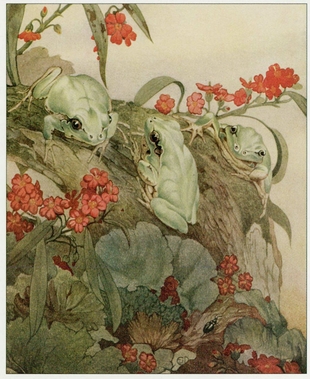INTRODUCTION

THE DETMOLD BROTHERS—twins Charles Maurice and Edward Julius—were born in London in November of 1883. It was an ideal time and place for the duo to thrive and indulge their interest in drawing and sketching. Both brothers showed such an amazing proficiency for drawing that they were sent to live with an uncle who was able to tutor them and nurture their artistic talents. In the years that followed, it was not unusual to find the boys drawing at the London Zoo or the Natural History Museum in South Kensington. With promising artistic futures ahead of them, the Detmolds submitted pieces regularly to competitions during their early teen years, and in 1897, both brothers exhibited work at the Royal Academy.
These early accomplishments did not go unnoticed, and before long, innovative publisher J. M. Dent commissioned the brothers to produce a book with twenty-four color images. A beautiful collection of illustration and design, Pictures from Birdland (1899) shows a myriad of cultural influences, from Japanese prints to the Art Nouveau graphics of the day. Soon after, the brothers continued to experiment with various media, including etching, woodcuts, and watercolor. Macmillan championed their efforts in 1903, publishing a portfolio of imagery from Rudyard Kipling’s The Jungle Book. It was a perfect fit for the brothers’ interest in natural subjects, and was first issued as a large portfolio of sixteen plates before being reprinted in 1908 along with the full text. The Jungle Book established their fine reputation for precise illustration, particularly for themes centered on animals and botanicals.
Seemingly on their way to a swift commercial and artistic success, it was a considerable tragedy that in April 1908, Maurice took his own life at the age of twenty-four. To this day, the circumstances of Maurice’s death are clouded in mystery, with little motive or explanation for his desperate act. The loss of his brother and creative partner crushed Edward, and it weighed heavily on him in the ensuing years.
Stunned by his personal tragedy, Edward immersed himself in his work, concentrating wholeheartedly on the projects that both he and his brother were to create together. In 1909 Edward went on to join Hodder & Stoughton, London’s premier gift-book publisher, and while there, he added The Fables of Aesop, with twenty-five color plates and numerous line art pieces, to his list of works.
Over the next fifteen years, Edward produced project after project of naturalist studies—often depicting birds, sometimes insects and mammals, and occasionally, plants. These flora and fauna comprised the vast majority of his list of subjects, with few exceptions. The natural imagery he was so fond of drawing while still a young man soon became his singular area of expertise. Only on rare occasions, and toward the end of his professional career, did Edward venture toward more mainstream illustrative topics.
The Arabian Nights—his last published book of plates—appeared in 1924, and it relied heavily on the strength of Edward’s penchant for animal illustration. After that, Detmold completed work for Hodder & Stoughton on an edition of Hans Christian Andersen’s Fairy Tales. Having already produced multiple illustrated editions of these tales, the publisher chose not to print Detmold’s set, and that decision still holds true today.
Discouraged and unsatisfied by many of the commissions he had taken in the previous decade and distraught over the politics and social direction that had brought about World War I, Edward began to withdraw from publishing, and the world in general. By the mid-1920s, still carrying the burden of his brother’s loss, he retired to Montgomeryshire to live with his widowed sister. It was not long before he became completely reclusive, and he remained with his sister until 1957, when he also took his own life.
The impressive body of work that Maurice and Edward left behind shows a remarkably sensitive appreciation for living things. Their joint fascination with nature is evident in their choice of subject matter, which paired popular illustration with realistic, scientific study. Greatly admired the world over, the imagery of the Detmold brothers constitutes a unique treasury, and this volume showcases their very best.
October 2008
JEFF A. MENGES